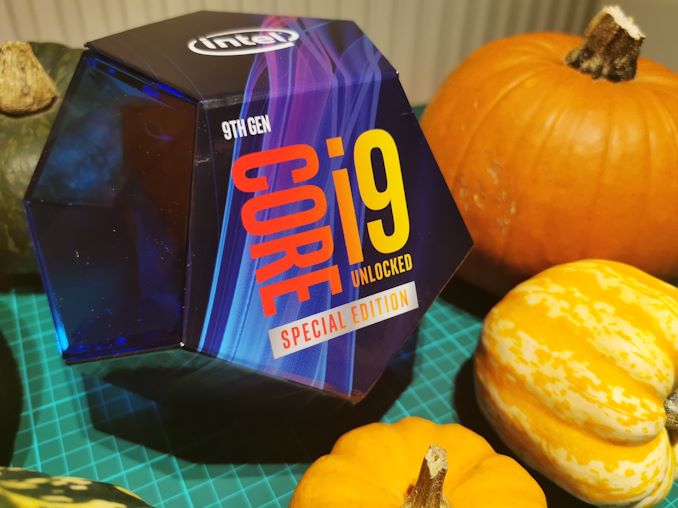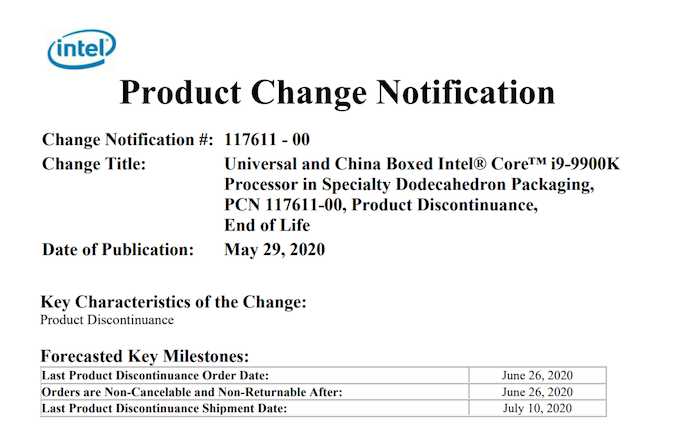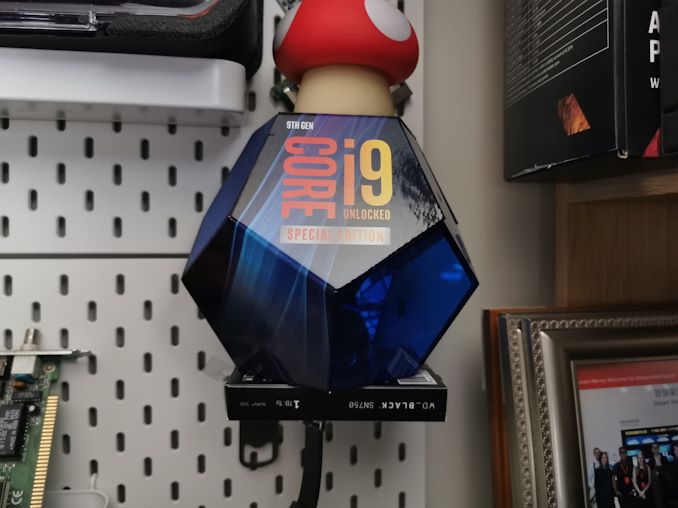Intel to Discontinue Core i9-9900K Special Dodecahedron Packaging
by Dr. Ian Cutress on May 30, 2020 8:00 AM EST- Posted in
- CPUs
- Intel
- Core i9
- Core i9-9900K

One of the interesting elements of this profession is dealing with how the processor companies have changed their attitudes towards marketing their products over the past couple of decades. After years of bland boxing and sub-standard coolers, there have been recent efforts to produce something eye-catching to users casually browsing shelves, especially in an effort to draw attention to the high-end products. While ultimately the packaging has little-to-no value after unboxing the product, beyond perhaps the background in a gaming stream, it does mark a change in attitudes, especially when product packaging can accelerate the hype around a product.
One of the recent product packaging efforts from Intel was the dodecahedral packaging for its halo desktop product, the Core i9-9900K. While AMD has focused special packaging for high-end desktop, Intel it seems prefers to point it into the desktop product line. This packaging is a transparent blue dodecahedron, with the CPU at the center. No cooler is bundled, and the packaging is large for the processor, but it certainly made it stand out.
Intel launched Comet Lake a couple of weeks ago, its 10th generation Core product, with the flagship i9-10900K sitting at the top of the stack. As the Core i9-9900K no longer sits in that top spot, Intel has decided to discontinue versions of the 9900K in its special packaging. Specifically, retailers have until June 26th to order these processor versions, and the last shipment will be on July 10th. This is a very quick discontinuance procedure, however the non-special retail version will still be available.
At some point in this market, we are going to get a product with iconic packaging. One could argue if the packaging makes the product interesting at all – given how users tend to focus on a specific processor for their build, is spending potentially slightly more for the fancy box ever justified? You may think that this news post is somewhat arbitrary, talking about packaging discontinuance, but it perhaps yields a bigger question in the processor market – does packaging matter? Or the contents – a message from the CEO on a special anniversary edition, or the signature on the heatspreader?
Related Reading
- The Intel Core i9-9900KS Review: The 5 GHz Consumer Special
- AMD Ryzen Threadripper 1950X and 1920X: We’re Allowed To Show Pictures Now
- The AMD Threadripper 2 Teaser: Pre-Orders Start Today, Up to 32 Cores
- Arm Development For The Office: Unboxing an Ampere eMag Workstation
- Huawei Mate 9 Porsche Design Unboxing and Hands On Benchmarks












41 Comments
View All Comments
willis936 - Saturday, May 30, 2020 - link
The plastic insert and barcodes are kept. The box gets tossed. I can't even see what Intel was trying to do here. It seems like someone suggested a fancy box will look cool and sell more units. Rather than cool, it looks like they're trying to trick me, a potential customer, into thinking they include a cooler in their massive box with a massive number on the sticker. It's all hot air.Retycint - Saturday, May 30, 2020 - link
Well, if you're going to build a high-end pc and buy the top end overclockable processor only to use the stock cooler, then perhaps you might have your priorities misalignedwillis936 - Saturday, May 30, 2020 - link
You’re not even presenting an argument here. The stock AMD coolers are sufficient to run AMD parts without thermal throttling and without overclocks. Overclocking headroom has never been lower. Gone are the days of 50% OC, or even 25% OC. If you want to spend $50 on a CPU cooler, you’re better off spending $50 on a better CPU. Is dropping the pomp for performance really a sign of misaligned priorities, or is it your priorities that are misaligned?CiccioB - Saturday, May 30, 2020 - link
This talking about the coolers that needs to be bought every time one install a new CPU is quite stupid.It's like saying that you need a new Monitor, Keyboard and mouse if you upgrade your case. Or you want them bundled with it because that way they are cheaper to have.
Once you have bought one of those 3rd party cooler you do not need to buy a new one until the install points on MB will change. It is about 10 years that they have not changed BTW. And with a different adapter the cost of few dollars you could mount it on new motherboard as you do when using the same cooler on Intel or AMD motherboards.
So, if I spent $50 on a cooler it is not worse than buying a better CPU once.
I buy the cooler once and then I can get better, faster, warmer CPU later. For many years in future. Without having to worry about it being bundled or not.
willis936 - Saturday, May 30, 2020 - link
Upgrade/maintenance of a system is a much lower cost and value than making a new system. It isn't stupid. It's a real cost and it really is incurred on customers.willis936 - Saturday, May 30, 2020 - link
There's a big flaw in this line of thinking:AMD includes CPU coolers with their CPUs that have motherboards that have mobo platforms that support 4 years of CPUs.
Intel doesn't include coolers and you need a new mobo with every new CPU.
So if you want to do upgrade/maintenance with Intel the incremental cost is larger than with AMD, yet Intel doesn't include the CPUs to make this option more economically sound? It doesn't add up. Intel just doesn't want to spend the money to bundle a cooler capable of cooling their 200W CPUs. The size of the cooler would also pretty embarrassing compared to their previously bundled coolers. Judging from these boxes they care a lot about their appearance.
PeachNCream - Saturday, May 30, 2020 - link
Some Intel boxed CPUs include coolers and thermal compound of some sort is typically applied but protected by a bit of plastic packaging. In fact, I think they don't include one only in the unlocked/overclock K chips. Typically, the default Intel cooler sold with their non-K chips is perfectly adequate. Typically chips with a stock cooler run at about 75-80C under load and the fan noise is only audible from close to the case in a quiet room. There is space for improvement so aftermarket coolers, if someone wants to spend the money, will give lower temps and likely less noise, but they are not ever necessary to keep a non-overclocked Intel chip healthy.With that said, AMD does do better with their boxed coolers. They are typically quieter and better able to keep temps under control in processors with the same rated TDP (though the difference in how Intel and AMD rate TDP is already well-known and should be considered).
brantron - Saturday, May 30, 2020 - link
lol I can say from experience the "65 watt" i7s of the last few years do not run 80 C under load with their dinky HSF. That's about half load. At full load, expect temperatures stuck at 100 C and clocks dropping to 3 GHz.To make it all the more ridiculous, Intel also has the much more appropriate BXTS15A HSF...sold separately.
PeachNCream - Tuesday, June 2, 2020 - link
As far as I've seen the difference in boxed vs aftermarket coolers for non-overclocked processors is basically a placebo level of performance gain for an additional cost that can otherwise be diverted into personal savings or invested in a retirement.Spunjji - Monday, June 1, 2020 - link
Sorry PeachNCream, but none of your commentary on the boxed cooler rings true for me.The boxed cooler with the non-K chips is extremely lightweight. It's just about sufficient for running at base clocks, but turbo speeds are in no way guaranteed. It may once have been able to keep a quad-core Haswell CPU at 80 degrees, but that's definitely not true for anything with 6 or more cores and/or a turbo above 4.5Ghz. In terms of noise, not only is it loud at full speed, it's also a very aggressive noise. It has a higher pitch than the average 120mm case fans and a tendency to buzz, which resonates through the cheap plastic frame into the lightweight aluminium fins.
It truly is the absolute bare minimum, and I have serious misgivings about anything in the 10 series above the i3 being able to perform properly underneath it.